Management and Operations : Toyota Motor Manufacturing Ltd
VerifiedAdded on 2021/01/02
|17
|5197
|239
AI Summary
Contribute Materials
Your contribution can guide someone’s learning journey. Share your
documents today.
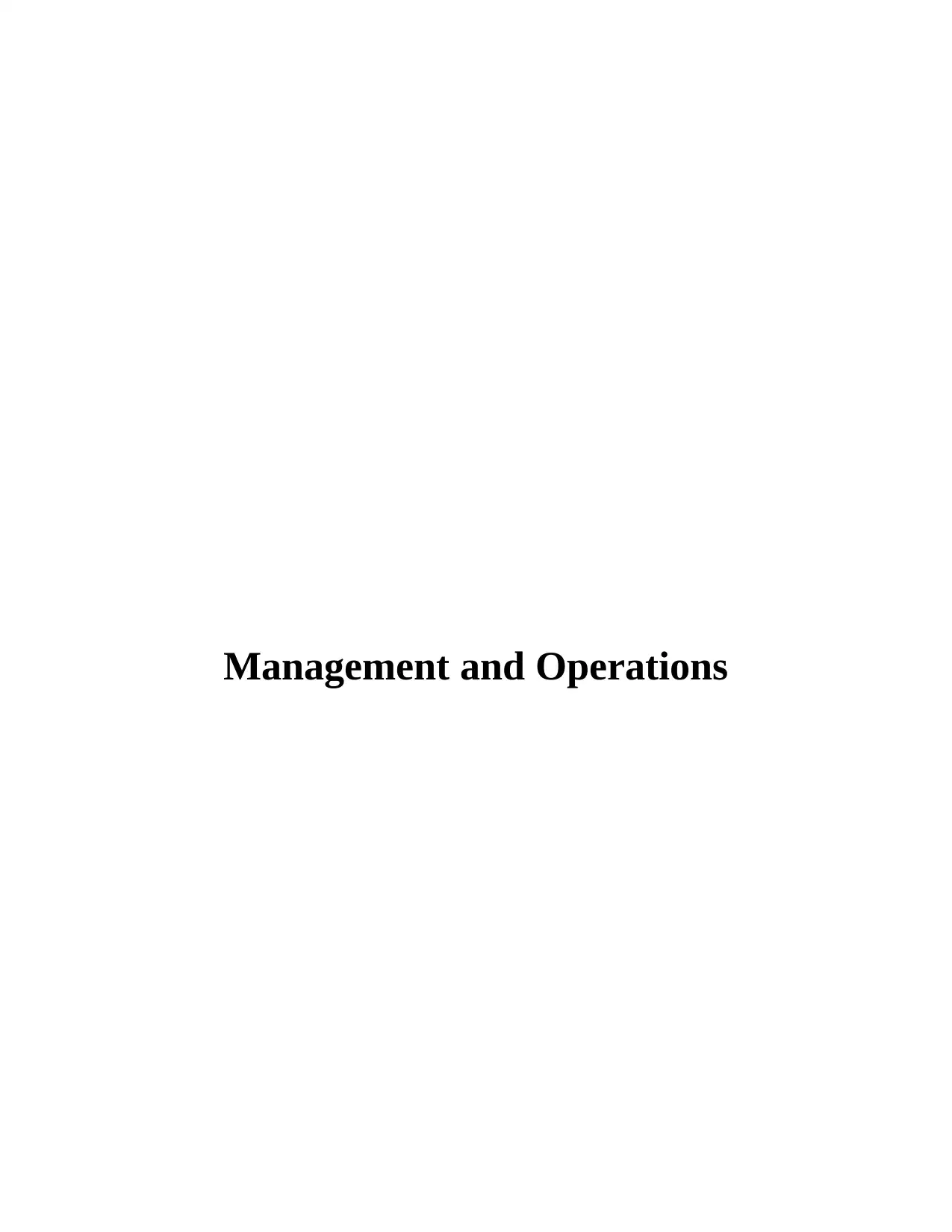
Management and Operations
Secure Best Marks with AI Grader
Need help grading? Try our AI Grader for instant feedback on your assignments.
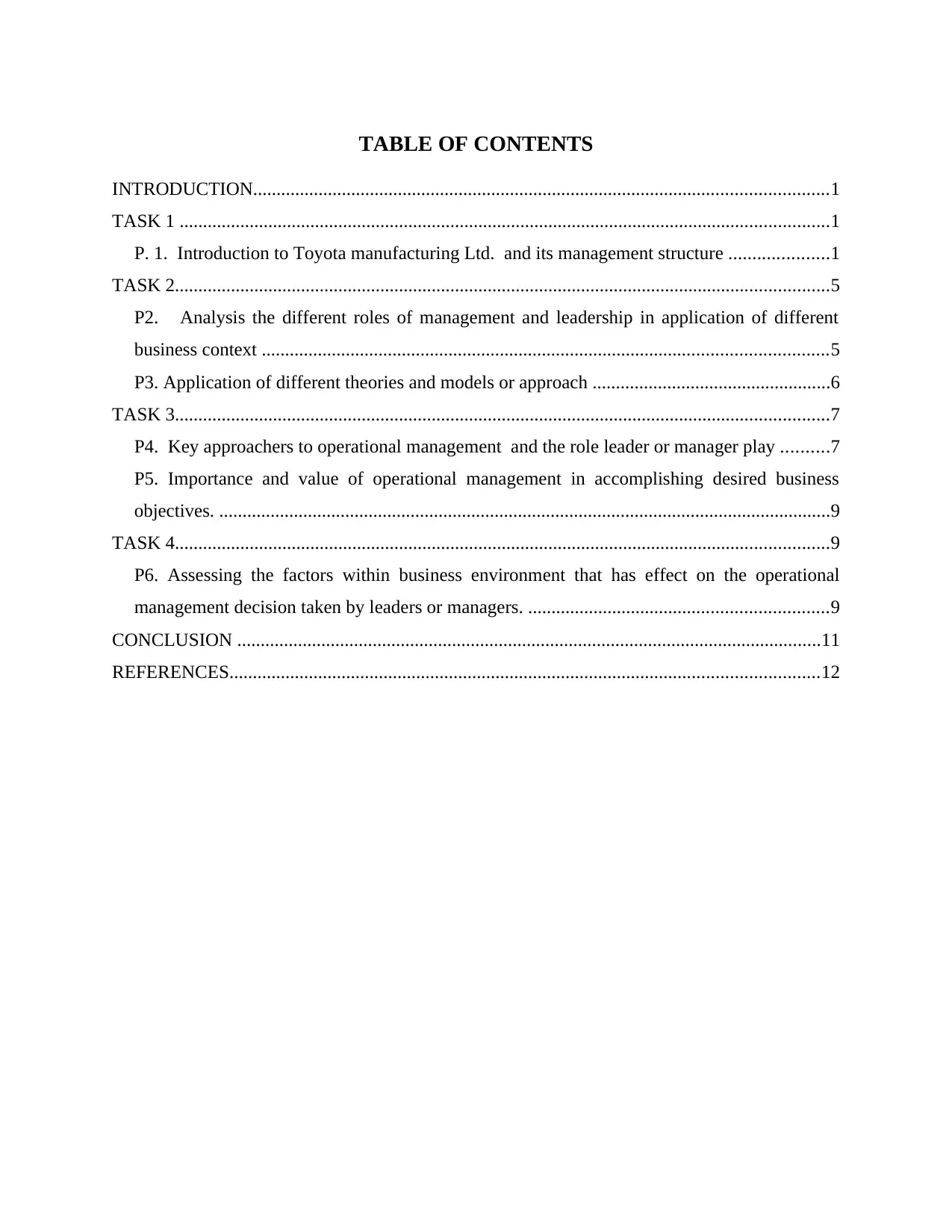
TABLE OF CONTENTS
INTRODUCTION...........................................................................................................................1
TASK 1 ...........................................................................................................................................1
P. 1. Introduction to Toyota manufacturing Ltd. and its management structure .....................1
TASK 2............................................................................................................................................5
P2. Analysis the different roles of management and leadership in application of different
business context .........................................................................................................................5
P3. Application of different theories and models or approach ...................................................6
TASK 3............................................................................................................................................7
P4. Key approachers to operational management and the role leader or manager play ..........7
P5. Importance and value of operational management in accomplishing desired business
objectives. ...................................................................................................................................9
TASK 4............................................................................................................................................9
P6. Assessing the factors within business environment that has effect on the operational
management decision taken by leaders or managers. ................................................................9
CONCLUSION .............................................................................................................................11
REFERENCES..............................................................................................................................12
INTRODUCTION...........................................................................................................................1
TASK 1 ...........................................................................................................................................1
P. 1. Introduction to Toyota manufacturing Ltd. and its management structure .....................1
TASK 2............................................................................................................................................5
P2. Analysis the different roles of management and leadership in application of different
business context .........................................................................................................................5
P3. Application of different theories and models or approach ...................................................6
TASK 3............................................................................................................................................7
P4. Key approachers to operational management and the role leader or manager play ..........7
P5. Importance and value of operational management in accomplishing desired business
objectives. ...................................................................................................................................9
TASK 4............................................................................................................................................9
P6. Assessing the factors within business environment that has effect on the operational
management decision taken by leaders or managers. ................................................................9
CONCLUSION .............................................................................................................................11
REFERENCES..............................................................................................................................12

INTRODUCTION
Management can be defined as distinct procedure which includes planning, organising,,
and controlling. It is the business functions which is performed in order to accomplish desired
objectives. An effective management and operations both are essential in order to drive an
enterprise towards success. Operation management can be defined as administration of business
practices which is done for creating a higher level of efficiency within a firm. It is the business
procedure which is mainly concerned with converting raw material as well as labour into
products or services for maximising profit. Operation management is the business activity which
is mainly concerned with designing of business operations as well as controlling production.
Proper operational management is important for smooth functioning of business.
The study will have focus on analysing the difference between role as well as
characteristics of manager or leaders in an enterprise in context of Toyota Motor manufacturing
Ltd. UK. It is basically a multinational company operating business in auto mobile industry.
Report also emphasizes on identification of different approaches to operational management.
TASK 1
P. 1. Introduction to Toyota manufacturing Ltd. and its management structure
Toyota was established in 1937. Toyota has been able to establish leading position in the
manufacturing auto mobile industry. Business entity manufacture as well as offers cars to
customers. Toyota is a first company in Auto mobile sector which has manufactured and
produced approx. 10 million cars in 2012 . In enterprise has also made announcements that it will
manufacture 200 million vehicles every year. There are approx. 369124 workers working in
Toyota company. The net income of Toyota during the year of 2018 was ¥2,586,106 million
(Slack and Brandon-Jones, 2018). In addition to this, business entity during the year 2018 had
turnover of ¥2,399,862 million (Chiarini and Brunetti, 2019). South Korea, Europe, India, Japan
and Indonesia are few nations where Toyota company is operating business. BMW, Hyundai,
Volkswagen, General motors Ford are few companies given stiff competition to Toyota.
Toyota company has tall as well as hierarchical management structure which has
provided firm an ease in accomplishing desired business objectives. Toyota company has many
management layers as well as long chain of command. All the important business decisions are
taken by senior management in an enterprise. Each functional unit in Toyota consist of
departmental head which is mainly responsible for managing the activities of employees working
Management can be defined as distinct procedure which includes planning, organising,,
and controlling. It is the business functions which is performed in order to accomplish desired
objectives. An effective management and operations both are essential in order to drive an
enterprise towards success. Operation management can be defined as administration of business
practices which is done for creating a higher level of efficiency within a firm. It is the business
procedure which is mainly concerned with converting raw material as well as labour into
products or services for maximising profit. Operation management is the business activity which
is mainly concerned with designing of business operations as well as controlling production.
Proper operational management is important for smooth functioning of business.
The study will have focus on analysing the difference between role as well as
characteristics of manager or leaders in an enterprise in context of Toyota Motor manufacturing
Ltd. UK. It is basically a multinational company operating business in auto mobile industry.
Report also emphasizes on identification of different approaches to operational management.
TASK 1
P. 1. Introduction to Toyota manufacturing Ltd. and its management structure
Toyota was established in 1937. Toyota has been able to establish leading position in the
manufacturing auto mobile industry. Business entity manufacture as well as offers cars to
customers. Toyota is a first company in Auto mobile sector which has manufactured and
produced approx. 10 million cars in 2012 . In enterprise has also made announcements that it will
manufacture 200 million vehicles every year. There are approx. 369124 workers working in
Toyota company. The net income of Toyota during the year of 2018 was ¥2,586,106 million
(Slack and Brandon-Jones, 2018). In addition to this, business entity during the year 2018 had
turnover of ¥2,399,862 million (Chiarini and Brunetti, 2019). South Korea, Europe, India, Japan
and Indonesia are few nations where Toyota company is operating business. BMW, Hyundai,
Volkswagen, General motors Ford are few companies given stiff competition to Toyota.
Toyota company has tall as well as hierarchical management structure which has
provided firm an ease in accomplishing desired business objectives. Toyota company has many
management layers as well as long chain of command. All the important business decisions are
taken by senior management in an enterprise. Each functional unit in Toyota consist of
departmental head which is mainly responsible for managing the activities of employees working
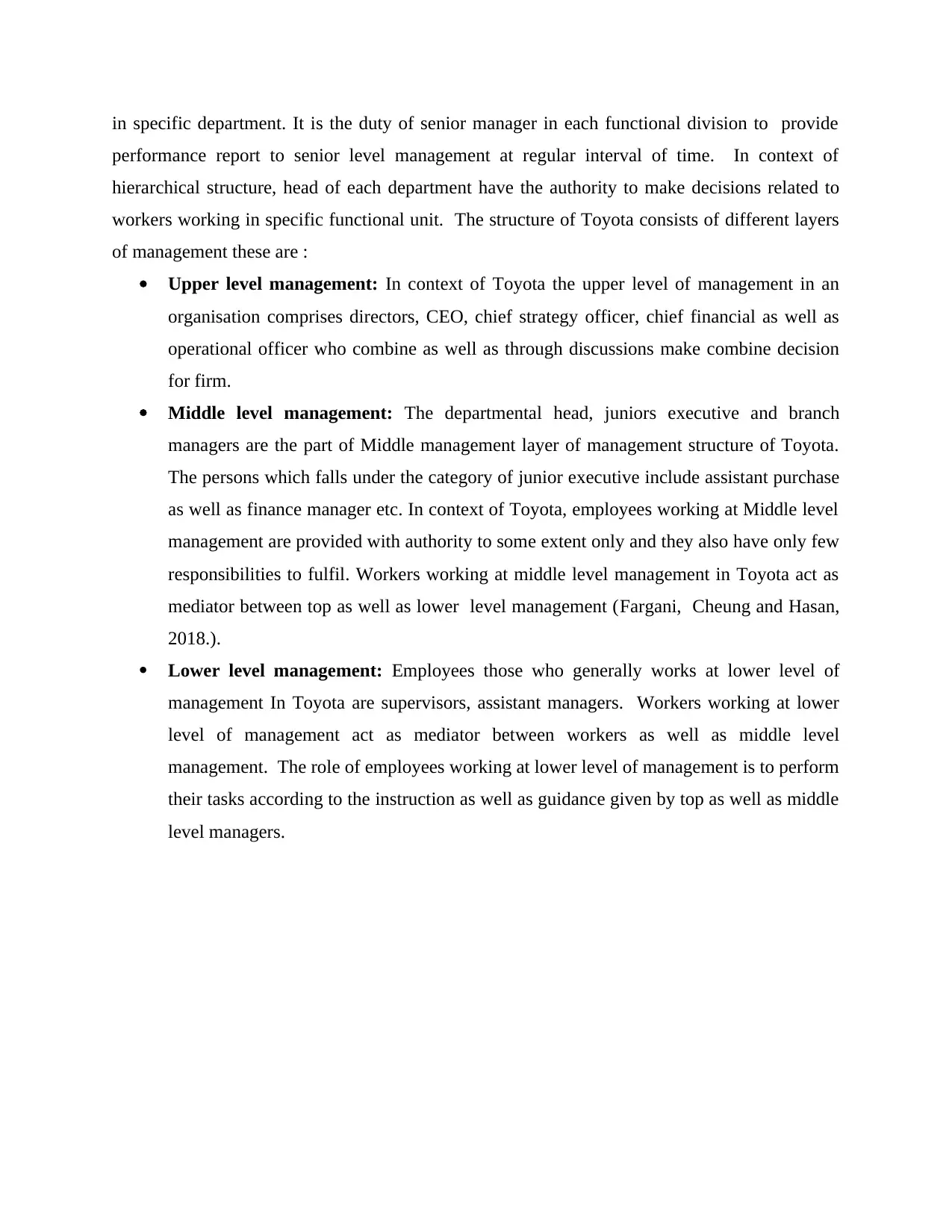
in specific department. It is the duty of senior manager in each functional division to provide
performance report to senior level management at regular interval of time. In context of
hierarchical structure, head of each department have the authority to make decisions related to
workers working in specific functional unit. The structure of Toyota consists of different layers
of management these are :
Upper level management: In context of Toyota the upper level of management in an
organisation comprises directors, CEO, chief strategy officer, chief financial as well as
operational officer who combine as well as through discussions make combine decision
for firm.
Middle level management: The departmental head, juniors executive and branch
managers are the part of Middle management layer of management structure of Toyota.
The persons which falls under the category of junior executive include assistant purchase
as well as finance manager etc. In context of Toyota, employees working at Middle level
management are provided with authority to some extent only and they also have only few
responsibilities to fulfil. Workers working at middle level management in Toyota act as
mediator between top as well as lower level management (Fargani, Cheung and Hasan,
2018.).
Lower level management: Employees those who generally works at lower level of
management In Toyota are supervisors, assistant managers. Workers working at lower
level of management act as mediator between workers as well as middle level
management. The role of employees working at lower level of management is to perform
their tasks according to the instruction as well as guidance given by top as well as middle
level managers.
performance report to senior level management at regular interval of time. In context of
hierarchical structure, head of each department have the authority to make decisions related to
workers working in specific functional unit. The structure of Toyota consists of different layers
of management these are :
Upper level management: In context of Toyota the upper level of management in an
organisation comprises directors, CEO, chief strategy officer, chief financial as well as
operational officer who combine as well as through discussions make combine decision
for firm.
Middle level management: The departmental head, juniors executive and branch
managers are the part of Middle management layer of management structure of Toyota.
The persons which falls under the category of junior executive include assistant purchase
as well as finance manager etc. In context of Toyota, employees working at Middle level
management are provided with authority to some extent only and they also have only few
responsibilities to fulfil. Workers working at middle level management in Toyota act as
mediator between top as well as lower level management (Fargani, Cheung and Hasan,
2018.).
Lower level management: Employees those who generally works at lower level of
management In Toyota are supervisors, assistant managers. Workers working at lower
level of management act as mediator between workers as well as middle level
management. The role of employees working at lower level of management is to perform
their tasks according to the instruction as well as guidance given by top as well as middle
level managers.
Secure Best Marks with AI Grader
Need help grading? Try our AI Grader for instant feedback on your assignments.

Definition and roles of both managers and leaders, highlighting the differences between
management and leadership.
Leaders can be defined as a person who commands a group or company. It can also be
defined as a person who holds dominant or superior position in an organisation. Leaders can
also be referred to as an in charge group of people within an enterprise.
Manager can be recognised as a person who is in charge of group of business activities
within an organisation. In contact of the Toyota, manager in an enterprise is responsible for
managing both people and business operations. In addition to this, manager is responsible for
Illustration 1: Organisational structure of Toyota.
(Source :Discover ideas about Organizational Structure,2019)
Definition and roles of both managers and leaders, highlighting the differences between
management and leadership.
Leaders can be defined as a person who commands a group or company. It can also be
defined as a person who holds dominant or superior position in an organisation. Leaders can
also be referred to as an in charge group of people within an enterprise.
Manager can be recognised as a person who is in charge of group of business activities
within an organisation. In contact of the Toyota, manager in an enterprise is responsible for
managing both people and business operations. In addition to this, manager is responsible for
Illustration 1: Organisational structure of Toyota.
(Source :Discover ideas about Organizational Structure,2019)

supervising as well as positively influencing people to make their significant contribution in
accomplishment of desired business objectives.
In context of Toyota, the role of manager are :
Role of manager in Toyota is to create an effective business plan in order to drive firm
towards success. It is the duty of leaders to supports managers in formulation of
strategies.
It is the duty of manager in Toyota, to set objective or goals as well as standards and
inform the same to leaders.
Role of manager in Toyota company is to make sure that al the business activities are
being performed according to the expectations v and are valuable in terms of
accomplishment of desired organisation goals.
Role of leaders
Role of leaders in Toyota organisation is to make sure that all the standards are being followed
by workers. It is the duty of leaders in Toyota company to manage the performance of their
followers and motive them to make their valuable contribution in the accomplishment of desired
business objectives (Alexander, Antony and Rodgers, 2019).
Characteristics of manager in Toyota
In context of Toyota, manager in an organisation have experience as well as knowledge
about market as well as industry which assists them in making an effective business
decisions.
The manager in Toyota company have all those characteristics which is possessed by an
effective manager such as they have ability to direct people.
In addition to this, manager in Toyota organisation have high influencing power utilising
which they motivate other people to improve their performance and increase
participation in business activities.
Managers in Toyota company has an effective communication skills which has enabled
them to maintain the good relationship with workers.
Characteristics of leaders in Toyota
accomplishment of desired business objectives.
In context of Toyota, the role of manager are :
Role of manager in Toyota is to create an effective business plan in order to drive firm
towards success. It is the duty of leaders to supports managers in formulation of
strategies.
It is the duty of manager in Toyota, to set objective or goals as well as standards and
inform the same to leaders.
Role of manager in Toyota company is to make sure that al the business activities are
being performed according to the expectations v and are valuable in terms of
accomplishment of desired organisation goals.
Role of leaders
Role of leaders in Toyota organisation is to make sure that all the standards are being followed
by workers. It is the duty of leaders in Toyota company to manage the performance of their
followers and motive them to make their valuable contribution in the accomplishment of desired
business objectives (Alexander, Antony and Rodgers, 2019).
Characteristics of manager in Toyota
In context of Toyota, manager in an organisation have experience as well as knowledge
about market as well as industry which assists them in making an effective business
decisions.
The manager in Toyota company have all those characteristics which is possessed by an
effective manager such as they have ability to direct people.
In addition to this, manager in Toyota organisation have high influencing power utilising
which they motivate other people to improve their performance and increase
participation in business activities.
Managers in Toyota company has an effective communication skills which has enabled
them to maintain the good relationship with workers.
Characteristics of leaders in Toyota
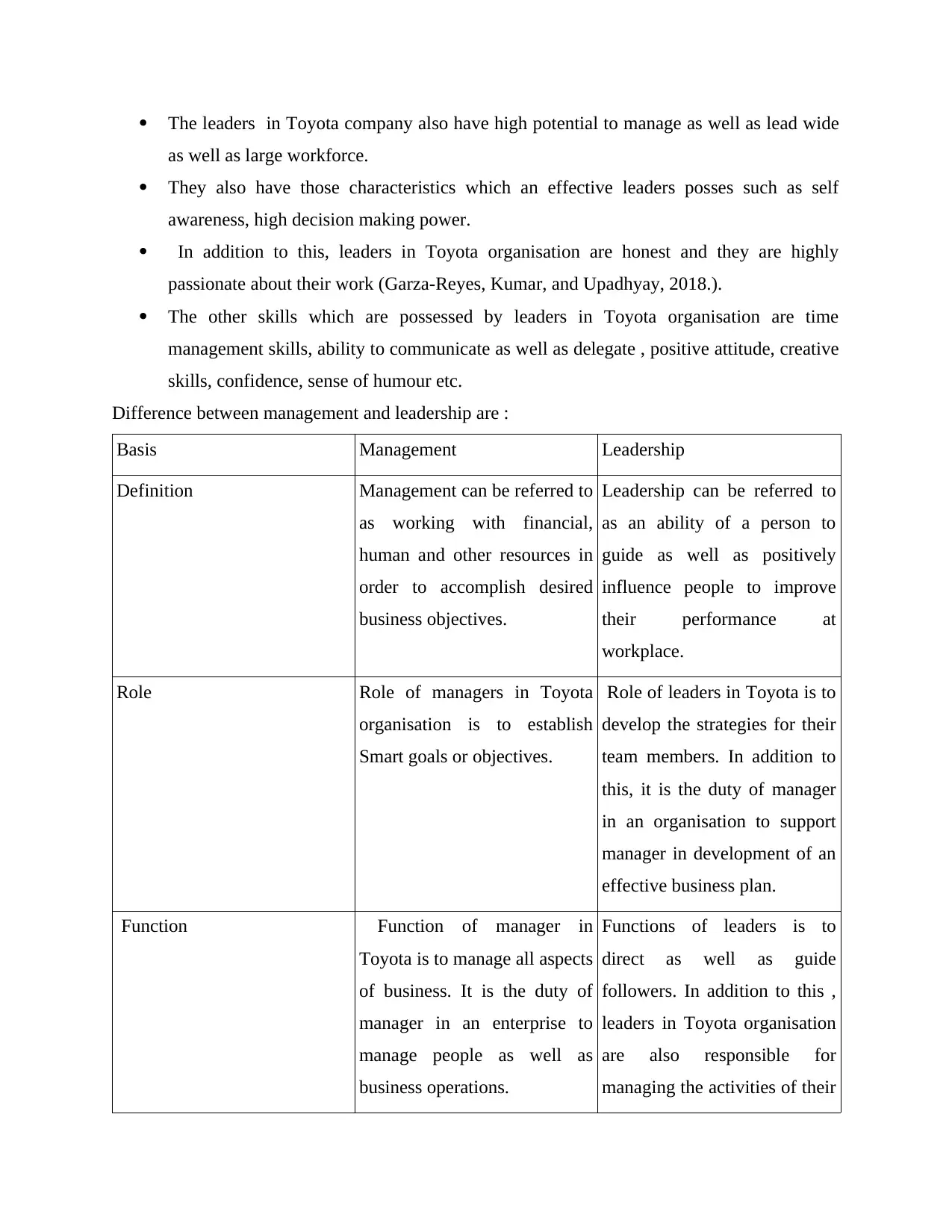
The leaders in Toyota company also have high potential to manage as well as lead wide
as well as large workforce.
They also have those characteristics which an effective leaders posses such as self
awareness, high decision making power.
In addition to this, leaders in Toyota organisation are honest and they are highly
passionate about their work (Garza-Reyes, Kumar, and Upadhyay, 2018.).
The other skills which are possessed by leaders in Toyota organisation are time
management skills, ability to communicate as well as delegate , positive attitude, creative
skills, confidence, sense of humour etc.
Difference between management and leadership are :
Basis Management Leadership
Definition Management can be referred to
as working with financial,
human and other resources in
order to accomplish desired
business objectives.
Leadership can be referred to
as an ability of a person to
guide as well as positively
influence people to improve
their performance at
workplace.
Role Role of managers in Toyota
organisation is to establish
Smart goals or objectives.
Role of leaders in Toyota is to
develop the strategies for their
team members. In addition to
this, it is the duty of manager
in an organisation to support
manager in development of an
effective business plan.
Function Function of manager in
Toyota is to manage all aspects
of business. It is the duty of
manager in an enterprise to
manage people as well as
business operations.
Functions of leaders is to
direct as well as guide
followers. In addition to this ,
leaders in Toyota organisation
are also responsible for
managing the activities of their
as well as large workforce.
They also have those characteristics which an effective leaders posses such as self
awareness, high decision making power.
In addition to this, leaders in Toyota organisation are honest and they are highly
passionate about their work (Garza-Reyes, Kumar, and Upadhyay, 2018.).
The other skills which are possessed by leaders in Toyota organisation are time
management skills, ability to communicate as well as delegate , positive attitude, creative
skills, confidence, sense of humour etc.
Difference between management and leadership are :
Basis Management Leadership
Definition Management can be referred to
as working with financial,
human and other resources in
order to accomplish desired
business objectives.
Leadership can be referred to
as an ability of a person to
guide as well as positively
influence people to improve
their performance at
workplace.
Role Role of managers in Toyota
organisation is to establish
Smart goals or objectives.
Role of leaders in Toyota is to
develop the strategies for their
team members. In addition to
this, it is the duty of manager
in an organisation to support
manager in development of an
effective business plan.
Function Function of manager in
Toyota is to manage all aspects
of business. It is the duty of
manager in an enterprise to
manage people as well as
business operations.
Functions of leaders is to
direct as well as guide
followers. In addition to this ,
leaders in Toyota organisation
are also responsible for
managing the activities of their
Paraphrase This Document
Need a fresh take? Get an instant paraphrase of this document with our AI Paraphraser
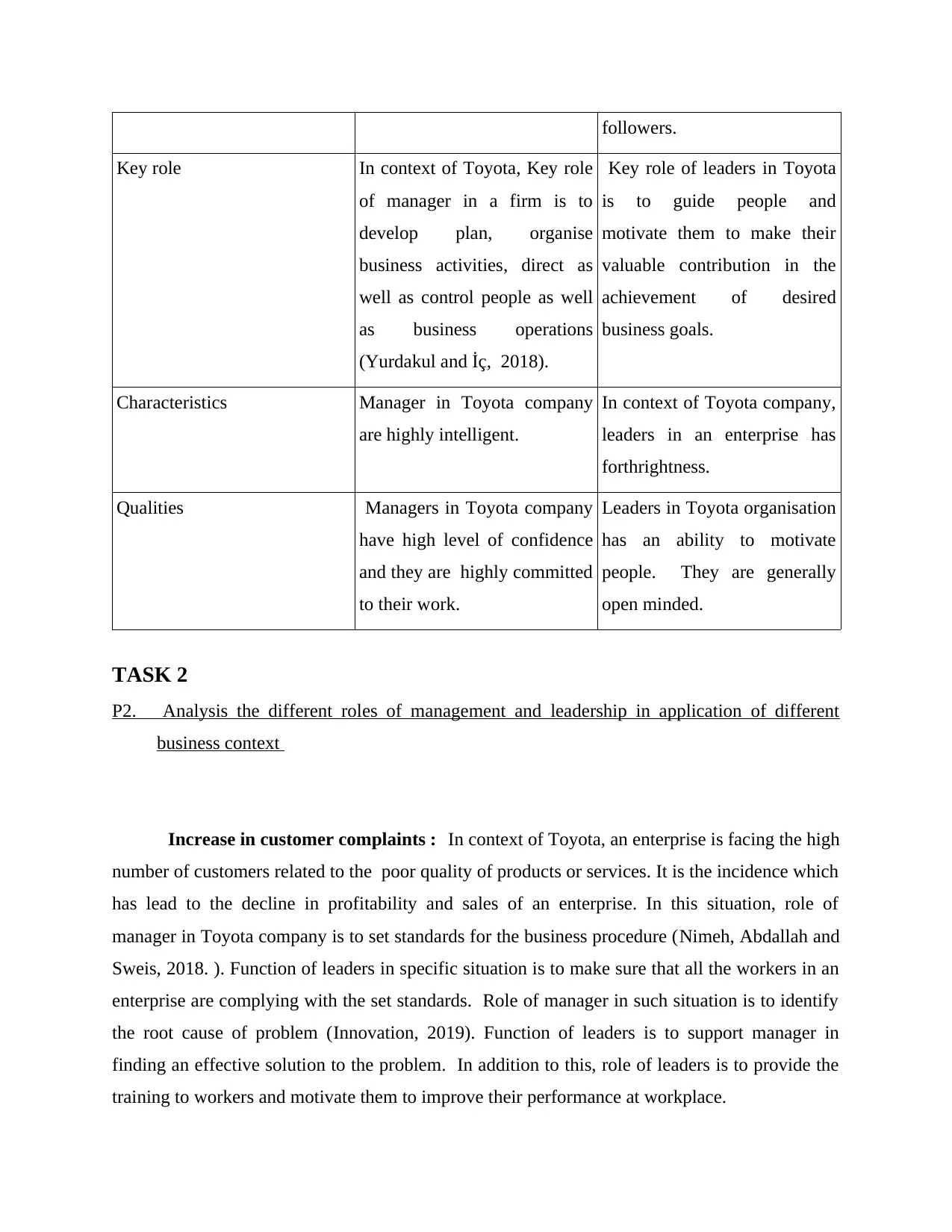
followers.
Key role In context of Toyota, Key role
of manager in a firm is to
develop plan, organise
business activities, direct as
well as control people as well
as business operations
(Yurdakul and İç, 2018).
Key role of leaders in Toyota
is to guide people and
motivate them to make their
valuable contribution in the
achievement of desired
business goals.
Characteristics Manager in Toyota company
are highly intelligent.
In context of Toyota company,
leaders in an enterprise has
forthrightness.
Qualities Managers in Toyota company
have high level of confidence
and they are highly committed
to their work.
Leaders in Toyota organisation
has an ability to motivate
people. They are generally
open minded.
TASK 2
P2. Analysis the different roles of management and leadership in application of different
business context
Increase in customer complaints : In context of Toyota, an enterprise is facing the high
number of customers related to the poor quality of products or services. It is the incidence which
has lead to the decline in profitability and sales of an enterprise. In this situation, role of
manager in Toyota company is to set standards for the business procedure (Nimeh, Abdallah and
Sweis, 2018. ). Function of leaders in specific situation is to make sure that all the workers in an
enterprise are complying with the set standards. Role of manager in such situation is to identify
the root cause of problem (Innovation, 2019). Function of leaders is to support manager in
finding an effective solution to the problem. In addition to this, role of leaders is to provide the
training to workers and motivate them to improve their performance at workplace.
Key role In context of Toyota, Key role
of manager in a firm is to
develop plan, organise
business activities, direct as
well as control people as well
as business operations
(Yurdakul and İç, 2018).
Key role of leaders in Toyota
is to guide people and
motivate them to make their
valuable contribution in the
achievement of desired
business goals.
Characteristics Manager in Toyota company
are highly intelligent.
In context of Toyota company,
leaders in an enterprise has
forthrightness.
Qualities Managers in Toyota company
have high level of confidence
and they are highly committed
to their work.
Leaders in Toyota organisation
has an ability to motivate
people. They are generally
open minded.
TASK 2
P2. Analysis the different roles of management and leadership in application of different
business context
Increase in customer complaints : In context of Toyota, an enterprise is facing the high
number of customers related to the poor quality of products or services. It is the incidence which
has lead to the decline in profitability and sales of an enterprise. In this situation, role of
manager in Toyota company is to set standards for the business procedure (Nimeh, Abdallah and
Sweis, 2018. ). Function of leaders in specific situation is to make sure that all the workers in an
enterprise are complying with the set standards. Role of manager in such situation is to identify
the root cause of problem (Innovation, 2019). Function of leaders is to support manager in
finding an effective solution to the problem. In addition to this, role of leaders is to provide the
training to workers and motivate them to improve their performance at workplace.

High level of employee turnover -In context of Toyota, the main issue faced by
organisation is high employee turnover. The main reason for high staff turnover rate is
ineffective as well as unsafe working environment. Therefore, manager or leaders in an
enterprise is required to take high initiative for bringing improvement in environment, as it will
assist them in dealing with the issue of high staff turnover .
Decline in productivity of firm -It has been there has been decline in the productivity of
Toyota company, the reason behind such issue is in appropriate as well as casual behaviour of
workers towards work. Management in Toyota company is required to enforce strict regulation
as it will assist them in proper behaviour. In such situation, function of leaders is to provide
training to workers, as it will help them in ensuring professional behaviour of employees.In
context of Toyota, due to ineffective management policies there has been high level of
dissatisfaction in employees which has lead to the decline in the productivity of an enterprise it
has further resulted in decline in sales of company. In such situation role of manager in an
organisation is to make amendments in existing policies. Function of leaders in such situation is
to inform, workers about the changes in policies.
P3. Application of different theories and models or approach
Contingency theory : Contingency theory of leadership is basically an organisation theory
which states that there is not the best way to organise business or to lead an enterprise. It is the
hypothesis which also states that the optimal course of action is highly influenced by either
internal or external factors. In context of Toyota company, employees in an enterprise are facing
the work place related issues, leader in Toyota is required to provide workers with guidance
related to their behaviour at workplace. In addition to this, leaders in an organisation is required
to communicate the expectation which they have from employees in context of behaviour.
Management in Toyota company is required to take strict against those workers those who
misbehave, as this tactic will aid them in limiting the unethical behaviour at workplace. This
hypothesis states that effectiveness of leaders can be measured on the basis of leadership which
matches to their situation (Innovation, 2019).
The biggest strength of contingency theory is that it is one of an appropriate way to
define the way good leadership can be achieved. In addition to this, the other major strength is
that it is tested as well as supported by research (Bhatia and Awasthi, 2018). It assists an
individual in developing the in depth knowledge about leadership. Contingency theory relates
organisation is high employee turnover. The main reason for high staff turnover rate is
ineffective as well as unsafe working environment. Therefore, manager or leaders in an
enterprise is required to take high initiative for bringing improvement in environment, as it will
assist them in dealing with the issue of high staff turnover .
Decline in productivity of firm -It has been there has been decline in the productivity of
Toyota company, the reason behind such issue is in appropriate as well as casual behaviour of
workers towards work. Management in Toyota company is required to enforce strict regulation
as it will assist them in proper behaviour. In such situation, function of leaders is to provide
training to workers, as it will help them in ensuring professional behaviour of employees.In
context of Toyota, due to ineffective management policies there has been high level of
dissatisfaction in employees which has lead to the decline in the productivity of an enterprise it
has further resulted in decline in sales of company. In such situation role of manager in an
organisation is to make amendments in existing policies. Function of leaders in such situation is
to inform, workers about the changes in policies.
P3. Application of different theories and models or approach
Contingency theory : Contingency theory of leadership is basically an organisation theory
which states that there is not the best way to organise business or to lead an enterprise. It is the
hypothesis which also states that the optimal course of action is highly influenced by either
internal or external factors. In context of Toyota company, employees in an enterprise are facing
the work place related issues, leader in Toyota is required to provide workers with guidance
related to their behaviour at workplace. In addition to this, leaders in an organisation is required
to communicate the expectation which they have from employees in context of behaviour.
Management in Toyota company is required to take strict against those workers those who
misbehave, as this tactic will aid them in limiting the unethical behaviour at workplace. This
hypothesis states that effectiveness of leaders can be measured on the basis of leadership which
matches to their situation (Innovation, 2019).
The biggest strength of contingency theory is that it is one of an appropriate way to
define the way good leadership can be achieved. In addition to this, the other major strength is
that it is tested as well as supported by research (Bhatia and Awasthi, 2018). It assists an
individual in developing the in depth knowledge about leadership. Contingency theory relates

leadership with situation. It is required by leaders in Toyota company to use this hypothesis, as it
will assist them in determining the best leadership style which is suitable for specific situation.
Weakness of contingency theory is that it doesn't provide the justification for effective of
leaders in some situations only.
Situation theory - According to this, hypothesis, leaders in Toyota organisation need to adopt
the leadership style considering the requirement of situation as well as development need of their
followers. It is the hypothesis which states that no single leadership style is not suitable for
dealing with all types of situation in business. The major strength of situational leadership theory
is that it is sensible, easy to understand and could be applied in different situation. The Biggest
weakness of situational leadership is that it is quite difficult to define the way commitment is
conceptualised as per the model.
System theory : The system theory has enabled leaders in Toyota company to built an effective
environment so that workers in an enterprise can potentially work. It is the hypothesis which has
assisted leaders in Toyota company to identify suitable ways to reduce the wastage of resources
as well as to prevent the overlapping of business activities. It is the hypothesis which states that
leaders can not bring change alone, they need support of other people in order to bring positive
change in the system. The major strength of system theory is that it is basically a practical
approach which can be easily understood (Lawrence, 2018.). It can also be applied in different
organisational setting. In context of Toyota company, leaders in an organisation can adopt this
theory as it will assist them in analysing the way they should act for increasing effectiveness.
The biggest weakness is that the implementation of system theory might lead to delay in decision
making procedure.
Scientific management theory : It analyses as well as synthesise workflow. Management in
Toyota company has adopted this theory as it helps in identification of suitable ways to increase
economic efficiency as well as labour productivity.
Elton Mayos behavioural theory of management, states that increase in the productivity
results from supervisory arrangement. It also states that the interest which leaders or managers in
an enterprise shows in fulfilling the needs of workers it leads to the high level of satisfaction in
workers and result of which can be measured in terms of increase in productivity that has further
lead to the increase in sustainability of firm.
will assist them in determining the best leadership style which is suitable for specific situation.
Weakness of contingency theory is that it doesn't provide the justification for effective of
leaders in some situations only.
Situation theory - According to this, hypothesis, leaders in Toyota organisation need to adopt
the leadership style considering the requirement of situation as well as development need of their
followers. It is the hypothesis which states that no single leadership style is not suitable for
dealing with all types of situation in business. The major strength of situational leadership theory
is that it is sensible, easy to understand and could be applied in different situation. The Biggest
weakness of situational leadership is that it is quite difficult to define the way commitment is
conceptualised as per the model.
System theory : The system theory has enabled leaders in Toyota company to built an effective
environment so that workers in an enterprise can potentially work. It is the hypothesis which has
assisted leaders in Toyota company to identify suitable ways to reduce the wastage of resources
as well as to prevent the overlapping of business activities. It is the hypothesis which states that
leaders can not bring change alone, they need support of other people in order to bring positive
change in the system. The major strength of system theory is that it is basically a practical
approach which can be easily understood (Lawrence, 2018.). It can also be applied in different
organisational setting. In context of Toyota company, leaders in an organisation can adopt this
theory as it will assist them in analysing the way they should act for increasing effectiveness.
The biggest weakness is that the implementation of system theory might lead to delay in decision
making procedure.
Scientific management theory : It analyses as well as synthesise workflow. Management in
Toyota company has adopted this theory as it helps in identification of suitable ways to increase
economic efficiency as well as labour productivity.
Elton Mayos behavioural theory of management, states that increase in the productivity
results from supervisory arrangement. It also states that the interest which leaders or managers in
an enterprise shows in fulfilling the needs of workers it leads to the high level of satisfaction in
workers and result of which can be measured in terms of increase in productivity that has further
lead to the increase in sustainability of firm.
Secure Best Marks with AI Grader
Need help grading? Try our AI Grader for instant feedback on your assignments.

TASK 3
P4. Key approachers to operational management and the role leader or manager play
Operational management is the business activity which is mainly concerned with
transforming input into out in effective manner. In context of Toyota, it is the core functions of
the company which is mainly concerned with designing as well as controlling the production
process.
The different approaches to operational management are :
Total quality management : It is one of the structured approach to quality management.
Total quality management approach can be applied by Toyota for overall business management.
It is the operational management approach which mainly concentrates on bringing the positive
improvement in the quality production output. It is the operational management approach which
mainly focuses on bringing improvement in the internal business procedure of an organisation.
Management in Toyota company is required to adopt total quality management as an approach to
operational management as it will assist business entity in providing high value proposition as
well as high satisfaction to their clients. It is the approach which will also aid an enterprise in
reducing the cost of operation's hence will assist an organisation in increasing profitability. The
purpose of manager in Toyota organisation is to provide suitable guidance to the team members
so that desired operational objectives could be accomplished. The activities which are performed
by leaders or managers in an organisation have positive effect on operational activities of an
organisation as it is the managers which make sure that all the business operations are performed
in an appropriate manner. They design the several strategies and policies in order to help an
organisation in accomplishment of desired operational target
Six sigma: It is an approach which can be implemented for bringing improvement in
quality of operation by eliminating errors as defects. Six sigma approach can also be used by
Toyota, as it will assist them in improving their present operational procedure. It will also assist
firm in eliminating the defects from products or services (Theyel, Hofmann and Gregory,
2018.).. In context of the Toyota company, management in an enterprise has taken high initiative
to create creative, healthy and safe working environment so that employees in an organisation
can work easily and can concentrate on their task, this activity of management has assisted
Toyota in increasing productivity (Afy-Shararah and Rich, 2018. ).
P4. Key approachers to operational management and the role leader or manager play
Operational management is the business activity which is mainly concerned with
transforming input into out in effective manner. In context of Toyota, it is the core functions of
the company which is mainly concerned with designing as well as controlling the production
process.
The different approaches to operational management are :
Total quality management : It is one of the structured approach to quality management.
Total quality management approach can be applied by Toyota for overall business management.
It is the operational management approach which mainly concentrates on bringing the positive
improvement in the quality production output. It is the operational management approach which
mainly focuses on bringing improvement in the internal business procedure of an organisation.
Management in Toyota company is required to adopt total quality management as an approach to
operational management as it will assist business entity in providing high value proposition as
well as high satisfaction to their clients. It is the approach which will also aid an enterprise in
reducing the cost of operation's hence will assist an organisation in increasing profitability. The
purpose of manager in Toyota organisation is to provide suitable guidance to the team members
so that desired operational objectives could be accomplished. The activities which are performed
by leaders or managers in an organisation have positive effect on operational activities of an
organisation as it is the managers which make sure that all the business operations are performed
in an appropriate manner. They design the several strategies and policies in order to help an
organisation in accomplishment of desired operational target
Six sigma: It is an approach which can be implemented for bringing improvement in
quality of operation by eliminating errors as defects. Six sigma approach can also be used by
Toyota, as it will assist them in improving their present operational procedure. It will also assist
firm in eliminating the defects from products or services (Theyel, Hofmann and Gregory,
2018.).. In context of the Toyota company, management in an enterprise has taken high initiative
to create creative, healthy and safe working environment so that employees in an organisation
can work easily and can concentrate on their task, this activity of management has assisted
Toyota in increasing productivity (Afy-Shararah and Rich, 2018. ).
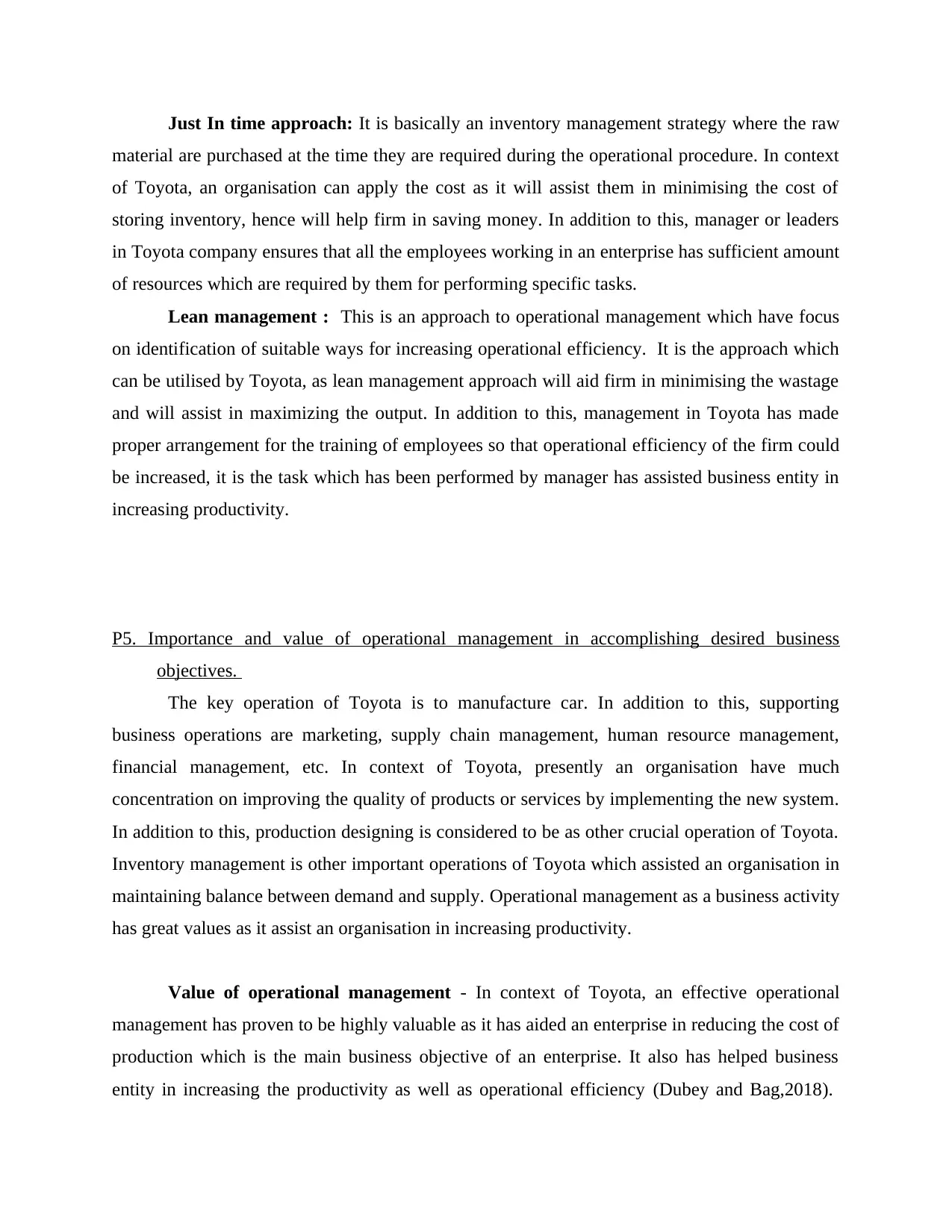
Just In time approach: It is basically an inventory management strategy where the raw
material are purchased at the time they are required during the operational procedure. In context
of Toyota, an organisation can apply the cost as it will assist them in minimising the cost of
storing inventory, hence will help firm in saving money. In addition to this, manager or leaders
in Toyota company ensures that all the employees working in an enterprise has sufficient amount
of resources which are required by them for performing specific tasks.
Lean management : This is an approach to operational management which have focus
on identification of suitable ways for increasing operational efficiency. It is the approach which
can be utilised by Toyota, as lean management approach will aid firm in minimising the wastage
and will assist in maximizing the output. In addition to this, management in Toyota has made
proper arrangement for the training of employees so that operational efficiency of the firm could
be increased, it is the task which has been performed by manager has assisted business entity in
increasing productivity.
P5. Importance and value of operational management in accomplishing desired business
objectives.
The key operation of Toyota is to manufacture car. In addition to this, supporting
business operations are marketing, supply chain management, human resource management,
financial management, etc. In context of Toyota, presently an organisation have much
concentration on improving the quality of products or services by implementing the new system.
In addition to this, production designing is considered to be as other crucial operation of Toyota.
Inventory management is other important operations of Toyota which assisted an organisation in
maintaining balance between demand and supply. Operational management as a business activity
has great values as it assist an organisation in increasing productivity.
Value of operational management - In context of Toyota, an effective operational
management has proven to be highly valuable as it has aided an enterprise in reducing the cost of
production which is the main business objective of an enterprise. It also has helped business
entity in increasing the productivity as well as operational efficiency (Dubey and Bag,2018).
material are purchased at the time they are required during the operational procedure. In context
of Toyota, an organisation can apply the cost as it will assist them in minimising the cost of
storing inventory, hence will help firm in saving money. In addition to this, manager or leaders
in Toyota company ensures that all the employees working in an enterprise has sufficient amount
of resources which are required by them for performing specific tasks.
Lean management : This is an approach to operational management which have focus
on identification of suitable ways for increasing operational efficiency. It is the approach which
can be utilised by Toyota, as lean management approach will aid firm in minimising the wastage
and will assist in maximizing the output. In addition to this, management in Toyota has made
proper arrangement for the training of employees so that operational efficiency of the firm could
be increased, it is the task which has been performed by manager has assisted business entity in
increasing productivity.
P5. Importance and value of operational management in accomplishing desired business
objectives.
The key operation of Toyota is to manufacture car. In addition to this, supporting
business operations are marketing, supply chain management, human resource management,
financial management, etc. In context of Toyota, presently an organisation have much
concentration on improving the quality of products or services by implementing the new system.
In addition to this, production designing is considered to be as other crucial operation of Toyota.
Inventory management is other important operations of Toyota which assisted an organisation in
maintaining balance between demand and supply. Operational management as a business activity
has great values as it assist an organisation in increasing productivity.
Value of operational management - In context of Toyota, an effective operational
management has proven to be highly valuable as it has aided an enterprise in reducing the cost of
production which is the main business objective of an enterprise. It also has helped business
entity in increasing the productivity as well as operational efficiency (Dubey and Bag,2018).
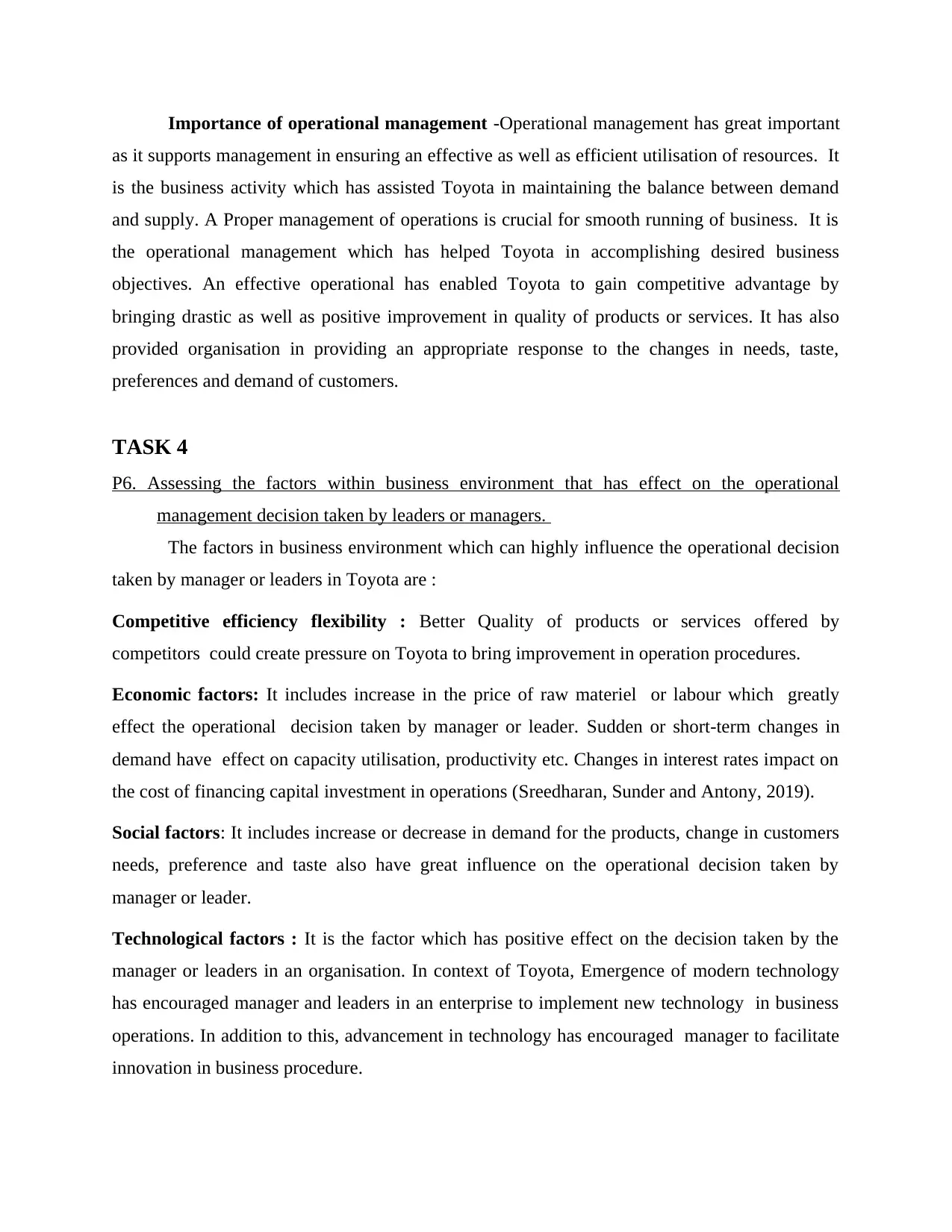
Importance of operational management -Operational management has great important
as it supports management in ensuring an effective as well as efficient utilisation of resources. It
is the business activity which has assisted Toyota in maintaining the balance between demand
and supply. A Proper management of operations is crucial for smooth running of business. It is
the operational management which has helped Toyota in accomplishing desired business
objectives. An effective operational has enabled Toyota to gain competitive advantage by
bringing drastic as well as positive improvement in quality of products or services. It has also
provided organisation in providing an appropriate response to the changes in needs, taste,
preferences and demand of customers.
TASK 4
P6. Assessing the factors within business environment that has effect on the operational
management decision taken by leaders or managers.
The factors in business environment which can highly influence the operational decision
taken by manager or leaders in Toyota are :
Competitive efficiency flexibility : Better Quality of products or services offered by
competitors could create pressure on Toyota to bring improvement in operation procedures.
Economic factors: It includes increase in the price of raw materiel or labour which greatly
effect the operational decision taken by manager or leader. Sudden or short-term changes in
demand have effect on capacity utilisation, productivity etc. Changes in interest rates impact on
the cost of financing capital investment in operations (Sreedharan, Sunder and Antony, 2019).
Social factors: It includes increase or decrease in demand for the products, change in customers
needs, preference and taste also have great influence on the operational decision taken by
manager or leader.
Technological factors : It is the factor which has positive effect on the decision taken by the
manager or leaders in an organisation. In context of Toyota, Emergence of modern technology
has encouraged manager and leaders in an enterprise to implement new technology in business
operations. In addition to this, advancement in technology has encouraged manager to facilitate
innovation in business procedure.
as it supports management in ensuring an effective as well as efficient utilisation of resources. It
is the business activity which has assisted Toyota in maintaining the balance between demand
and supply. A Proper management of operations is crucial for smooth running of business. It is
the operational management which has helped Toyota in accomplishing desired business
objectives. An effective operational has enabled Toyota to gain competitive advantage by
bringing drastic as well as positive improvement in quality of products or services. It has also
provided organisation in providing an appropriate response to the changes in needs, taste,
preferences and demand of customers.
TASK 4
P6. Assessing the factors within business environment that has effect on the operational
management decision taken by leaders or managers.
The factors in business environment which can highly influence the operational decision
taken by manager or leaders in Toyota are :
Competitive efficiency flexibility : Better Quality of products or services offered by
competitors could create pressure on Toyota to bring improvement in operation procedures.
Economic factors: It includes increase in the price of raw materiel or labour which greatly
effect the operational decision taken by manager or leader. Sudden or short-term changes in
demand have effect on capacity utilisation, productivity etc. Changes in interest rates impact on
the cost of financing capital investment in operations (Sreedharan, Sunder and Antony, 2019).
Social factors: It includes increase or decrease in demand for the products, change in customers
needs, preference and taste also have great influence on the operational decision taken by
manager or leader.
Technological factors : It is the factor which has positive effect on the decision taken by the
manager or leaders in an organisation. In context of Toyota, Emergence of modern technology
has encouraged manager and leaders in an enterprise to implement new technology in business
operations. In addition to this, advancement in technology has encouraged manager to facilitate
innovation in business procedure.
Paraphrase This Document
Need a fresh take? Get an instant paraphrase of this document with our AI Paraphraser
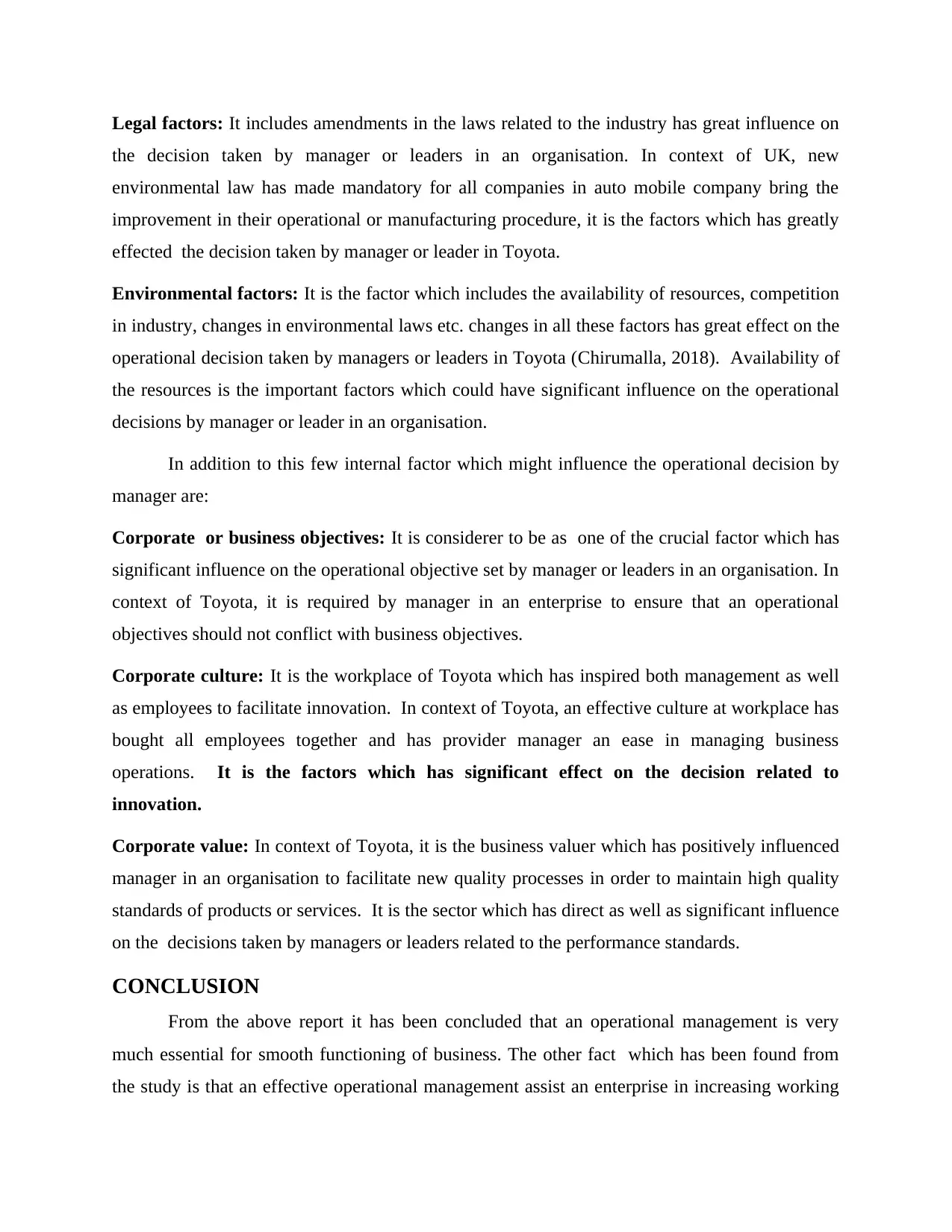
Legal factors: It includes amendments in the laws related to the industry has great influence on
the decision taken by manager or leaders in an organisation. In context of UK, new
environmental law has made mandatory for all companies in auto mobile company bring the
improvement in their operational or manufacturing procedure, it is the factors which has greatly
effected the decision taken by manager or leader in Toyota.
Environmental factors: It is the factor which includes the availability of resources, competition
in industry, changes in environmental laws etc. changes in all these factors has great effect on the
operational decision taken by managers or leaders in Toyota (Chirumalla, 2018). Availability of
the resources is the important factors which could have significant influence on the operational
decisions by manager or leader in an organisation.
In addition to this few internal factor which might influence the operational decision by
manager are:
Corporate or business objectives: It is considerer to be as one of the crucial factor which has
significant influence on the operational objective set by manager or leaders in an organisation. In
context of Toyota, it is required by manager in an enterprise to ensure that an operational
objectives should not conflict with business objectives.
Corporate culture: It is the workplace of Toyota which has inspired both management as well
as employees to facilitate innovation. In context of Toyota, an effective culture at workplace has
bought all employees together and has provider manager an ease in managing business
operations. It is the factors which has significant effect on the decision related to
innovation.
Corporate value: In context of Toyota, it is the business valuer which has positively influenced
manager in an organisation to facilitate new quality processes in order to maintain high quality
standards of products or services. It is the sector which has direct as well as significant influence
on the decisions taken by managers or leaders related to the performance standards.
CONCLUSION
From the above report it has been concluded that an operational management is very
much essential for smooth functioning of business. The other fact which has been found from
the study is that an effective operational management assist an enterprise in increasing working
the decision taken by manager or leaders in an organisation. In context of UK, new
environmental law has made mandatory for all companies in auto mobile company bring the
improvement in their operational or manufacturing procedure, it is the factors which has greatly
effected the decision taken by manager or leader in Toyota.
Environmental factors: It is the factor which includes the availability of resources, competition
in industry, changes in environmental laws etc. changes in all these factors has great effect on the
operational decision taken by managers or leaders in Toyota (Chirumalla, 2018). Availability of
the resources is the important factors which could have significant influence on the operational
decisions by manager or leader in an organisation.
In addition to this few internal factor which might influence the operational decision by
manager are:
Corporate or business objectives: It is considerer to be as one of the crucial factor which has
significant influence on the operational objective set by manager or leaders in an organisation. In
context of Toyota, it is required by manager in an enterprise to ensure that an operational
objectives should not conflict with business objectives.
Corporate culture: It is the workplace of Toyota which has inspired both management as well
as employees to facilitate innovation. In context of Toyota, an effective culture at workplace has
bought all employees together and has provider manager an ease in managing business
operations. It is the factors which has significant effect on the decision related to
innovation.
Corporate value: In context of Toyota, it is the business valuer which has positively influenced
manager in an organisation to facilitate new quality processes in order to maintain high quality
standards of products or services. It is the sector which has direct as well as significant influence
on the decisions taken by managers or leaders related to the performance standards.
CONCLUSION
From the above report it has been concluded that an operational management is very
much essential for smooth functioning of business. The other fact which has been found from
the study is that an effective operational management assist an enterprise in increasing working
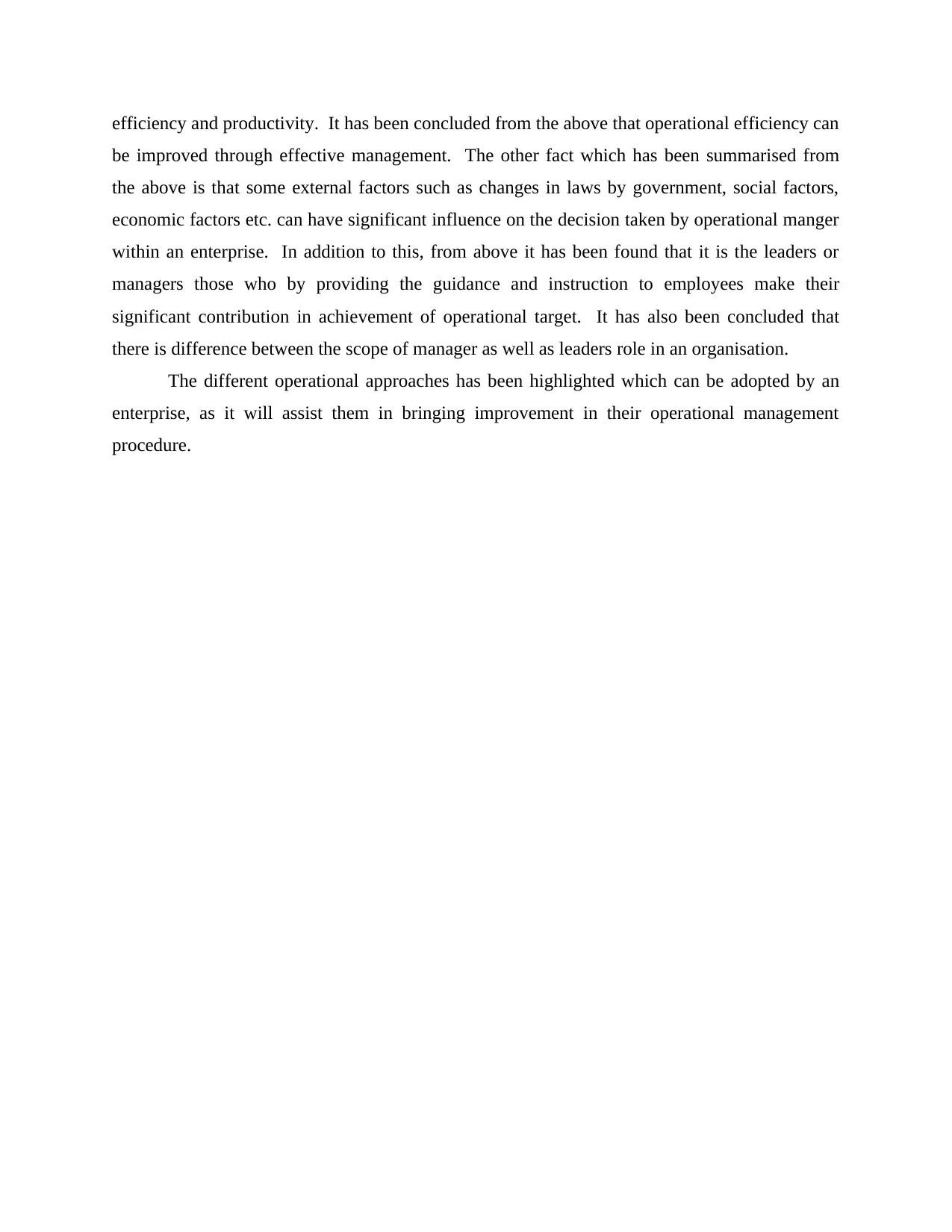
efficiency and productivity. It has been concluded from the above that operational efficiency can
be improved through effective management. The other fact which has been summarised from
the above is that some external factors such as changes in laws by government, social factors,
economic factors etc. can have significant influence on the decision taken by operational manger
within an enterprise. In addition to this, from above it has been found that it is the leaders or
managers those who by providing the guidance and instruction to employees make their
significant contribution in achievement of operational target. It has also been concluded that
there is difference between the scope of manager as well as leaders role in an organisation.
The different operational approaches has been highlighted which can be adopted by an
enterprise, as it will assist them in bringing improvement in their operational management
procedure.
be improved through effective management. The other fact which has been summarised from
the above is that some external factors such as changes in laws by government, social factors,
economic factors etc. can have significant influence on the decision taken by operational manger
within an enterprise. In addition to this, from above it has been found that it is the leaders or
managers those who by providing the guidance and instruction to employees make their
significant contribution in achievement of operational target. It has also been concluded that
there is difference between the scope of manager as well as leaders role in an organisation.
The different operational approaches has been highlighted which can be adopted by an
enterprise, as it will assist them in bringing improvement in their operational management
procedure.

REFERENCES
Books and Journals:
Nimeh, H.A., Abdallah, A.B. and Sweis, R., 2018. Lean supply chain management practices and
performance: empirical evidence from manufacturing companies. Int. J Sup. Chain. Mgt
Vol. 7(1). pp.1.
Fargani, H., Cheung, W.M. and Hasan, R., 2018. Ranking of factors that underlie the drivers of
sustainable manufacturing based on their variation in a sample of UK manufacturing
plants. IJMTM. 32(3). pp.297-311.
Slack, N. and Brandon-Jones, A., 2018. Operations and process management: principles and
practice for strategic impact. Pearson UK.
Chiarini, A. and Brunetti, F., 2019. What really matters for a successful implementation of Lean
production? A multiple linear regression model based on European manufacturing
companies. Production Planning & Control.pp.1-11.
Alexander, P., Antony, J. and Rodgers, B., 2019. Lean Six Sigma for small-and medium-sized
manufacturing enterprises: a systematic review. International Journal of Quality &
Reliability Management.
Garza-Reyes, J.A., Kumar, V. and Upadhyay, A., 2018. Total quality environmental
management: Adoption status in the Chinese manufacturing sector. The TQM
Journal.30(1). pp.2-19.
Yurdakul, M. and İç, Y.T., 2018. Development of a multi-level performance measurement model
for manufacturing companies using a modified version of the fuzzy TOPSIS approach. Soft
Computing. 22(22). pp.7491-7503.
Innovation, C., 2019. Information, Process, Management.
Bhatia, M.S. and Awasthi, A., 2018. Assessing relationship between quality management
systems and business performance and its mediators: SEM approach. International Journal
of Quality & Reliability Management.35(8). pp.1490-1507.
Lawrence, P., 2018. Management in Action. Routledge.
Theyel, G., Hofmann, K. and Gregory, M., 2018. Understanding Manufacturing Location
Decision Making: Rationales for Retaining, Offshoring, Reshoring, and Hybrid
Approaches. Economic Development Quarterly.32(4). pp.300-312.
Afy-Shararah, M. and Rich, N., 2018. Operations flow effectiveness: a systems approach to
measuring flow performance. International Journal of Operations & Production
Management/38(11). pp.2096-2123.
Dubey, R. and Bag, S., 2018. Antecedents of green manufacturing practices: a journey towards
manufacturing sustainability. In Operations and Service Management: Concepts,
Methodologies, Tools, and Applications (pp. 1271-1293). IGI Global.
Sreedharan V, R., Sunder M, V. and Antony, J., 2019. Assessment of Lean Six Sigma Readiness
(LESIRE) for manufacturing industries using fuzzy logic. International Journal of Quality
& Reliability Management.36(2). pp.137-161.
Books and Journals:
Nimeh, H.A., Abdallah, A.B. and Sweis, R., 2018. Lean supply chain management practices and
performance: empirical evidence from manufacturing companies. Int. J Sup. Chain. Mgt
Vol. 7(1). pp.1.
Fargani, H., Cheung, W.M. and Hasan, R., 2018. Ranking of factors that underlie the drivers of
sustainable manufacturing based on their variation in a sample of UK manufacturing
plants. IJMTM. 32(3). pp.297-311.
Slack, N. and Brandon-Jones, A., 2018. Operations and process management: principles and
practice for strategic impact. Pearson UK.
Chiarini, A. and Brunetti, F., 2019. What really matters for a successful implementation of Lean
production? A multiple linear regression model based on European manufacturing
companies. Production Planning & Control.pp.1-11.
Alexander, P., Antony, J. and Rodgers, B., 2019. Lean Six Sigma for small-and medium-sized
manufacturing enterprises: a systematic review. International Journal of Quality &
Reliability Management.
Garza-Reyes, J.A., Kumar, V. and Upadhyay, A., 2018. Total quality environmental
management: Adoption status in the Chinese manufacturing sector. The TQM
Journal.30(1). pp.2-19.
Yurdakul, M. and İç, Y.T., 2018. Development of a multi-level performance measurement model
for manufacturing companies using a modified version of the fuzzy TOPSIS approach. Soft
Computing. 22(22). pp.7491-7503.
Innovation, C., 2019. Information, Process, Management.
Bhatia, M.S. and Awasthi, A., 2018. Assessing relationship between quality management
systems and business performance and its mediators: SEM approach. International Journal
of Quality & Reliability Management.35(8). pp.1490-1507.
Lawrence, P., 2018. Management in Action. Routledge.
Theyel, G., Hofmann, K. and Gregory, M., 2018. Understanding Manufacturing Location
Decision Making: Rationales for Retaining, Offshoring, Reshoring, and Hybrid
Approaches. Economic Development Quarterly.32(4). pp.300-312.
Afy-Shararah, M. and Rich, N., 2018. Operations flow effectiveness: a systems approach to
measuring flow performance. International Journal of Operations & Production
Management/38(11). pp.2096-2123.
Dubey, R. and Bag, S., 2018. Antecedents of green manufacturing practices: a journey towards
manufacturing sustainability. In Operations and Service Management: Concepts,
Methodologies, Tools, and Applications (pp. 1271-1293). IGI Global.
Sreedharan V, R., Sunder M, V. and Antony, J., 2019. Assessment of Lean Six Sigma Readiness
(LESIRE) for manufacturing industries using fuzzy logic. International Journal of Quality
& Reliability Management.36(2). pp.137-161.
Secure Best Marks with AI Grader
Need help grading? Try our AI Grader for instant feedback on your assignments.
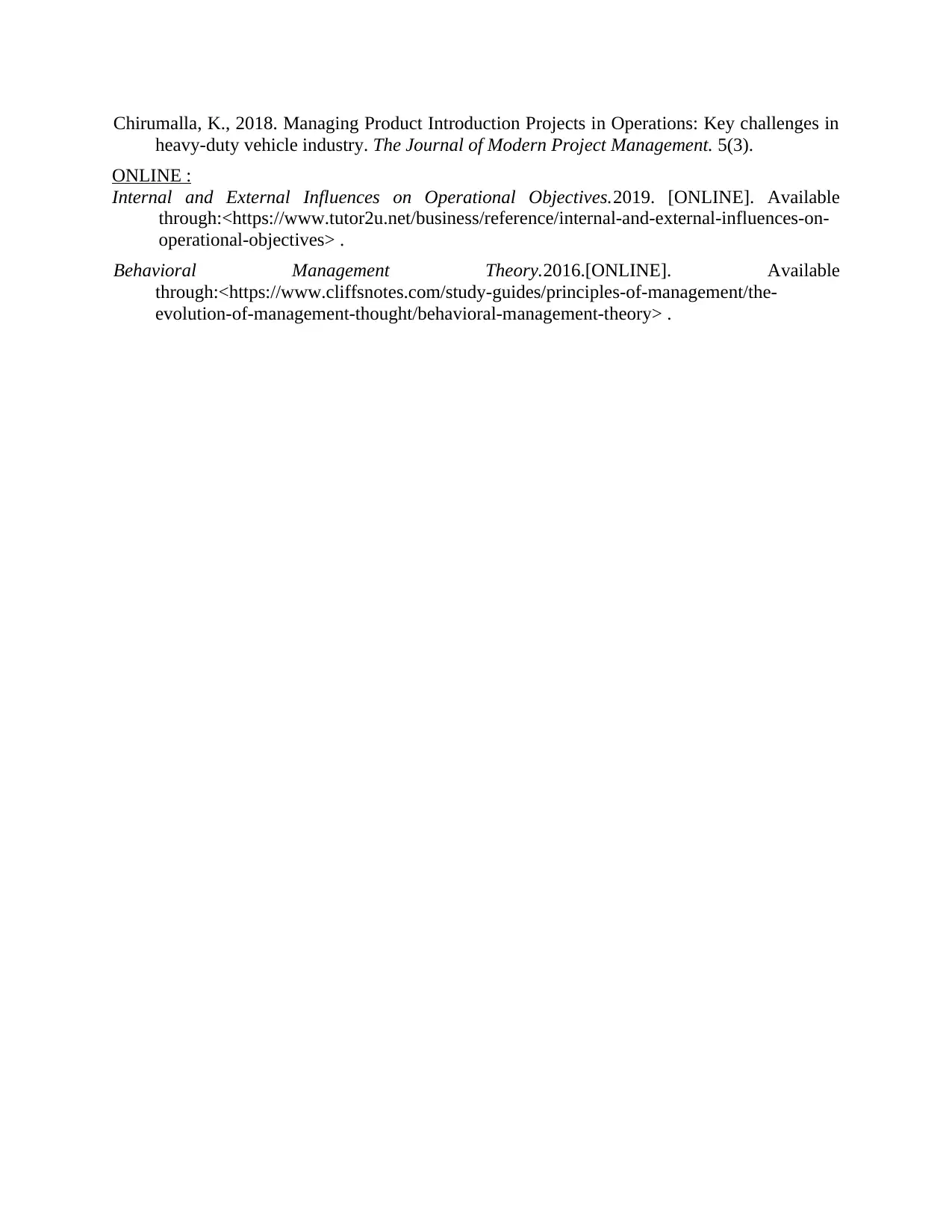
Chirumalla, K., 2018. Managing Product Introduction Projects in Operations: Key challenges in
heavy-duty vehicle industry. The Journal of Modern Project Management. 5(3).
ONLINE :
Internal and External Influences on Operational Objectives.2019. [ONLINE]. Available
through:<https://www.tutor2u.net/business/reference/internal-and-external-influences-on-
operational-objectives> .
Behavioral Management Theory.2016.[ONLINE]. Available
through:<https://www.cliffsnotes.com/study-guides/principles-of-management/the-
evolution-of-management-thought/behavioral-management-theory> .
heavy-duty vehicle industry. The Journal of Modern Project Management. 5(3).
ONLINE :
Internal and External Influences on Operational Objectives.2019. [ONLINE]. Available
through:<https://www.tutor2u.net/business/reference/internal-and-external-influences-on-
operational-objectives> .
Behavioral Management Theory.2016.[ONLINE]. Available
through:<https://www.cliffsnotes.com/study-guides/principles-of-management/the-
evolution-of-management-thought/behavioral-management-theory> .
1 out of 17
Related Documents
Your All-in-One AI-Powered Toolkit for Academic Success.
+13062052269
info@desklib.com
Available 24*7 on WhatsApp / Email
![[object Object]](/_next/static/media/star-bottom.7253800d.svg)
Unlock your academic potential
© 2024 | Zucol Services PVT LTD | All rights reserved.





